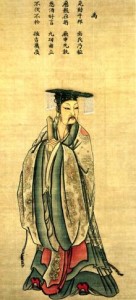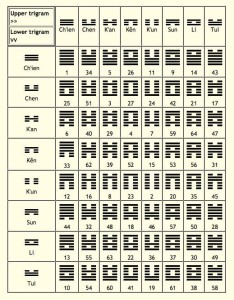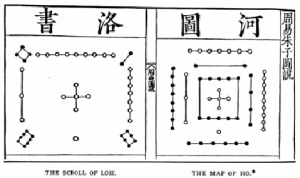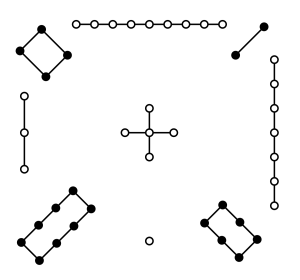Feng Shui origins: numbers are the right instruments to represent the logical sectors, the actual categories constituting the Universe. In this article we will explain the cultural origins of the magic square Lo Shu, a fundamental tool of Feng Shui methodology
News taken from the book by Marcel Granet: The Chinese Thought.Numbers are the correct means to draw the logical sectors, the actual categories constituting the universe. And if we aspect them to be represented according to their essence and to that constitutive order that Hong Fan calls “the regular relations of beings”, it is with the help of numbers that this goal can be reached. By choosing whatever arrangement of numbers allowing you to represent their games, you could believe you have succeeded in making the universe intelligible and adjustable at the same time.
All the virtues allowing a hero to rule the world were possessed by Yu the Great. So he founded the Hia dynasty, and it is to him, it is said, that Heaven entrusted “the 9 sections of the Hong Fan”. (洪範)
This does not mean that Heaven offered Yu a 9-point dissertation. In the literary composition that, after the end of the Yin, a prince of this fallen family recited to the founder of Tcheou, there was the supreme knowledge included in Yu’s Hong Fan, undoubtedly. But the meditations that had inspired this celestial document differed in the same way that apparently the literary glosses forming this sacred text of diviners differ from the authentic text of the Yi Jing. Sixty-four drawings, the Hexagrams, are the whole original text of the Yi Jing: all the rest is nothing but commentary, amplification, captions helping inthe task of deciphering the divinatory symbols. In these 64 graphic symbols a knowledge, a total power is contained . In the same way, undoubtedly, before it was clarified in the nine points of the dissertation recited before King Wou, a similar sum of knowledge was already found in the 9 Hong Fan columns – as Yu knew it.
Hong Fan means “great model” or “supreme plan”. What could the Headings of the Great Plan represent, if not a grouping of symbols capable of manifesting in the reality, as well as imposing on the mind, an order of categories evoking the universal order? Placed around number 5 (sign of supreme place and space), hat could these 9 numbered columns actually be, if not, simply, the first 9 numerical symbols?
Surely what Heaven delivered to Yu was not the gloss to the text but its own letter, or rather its cypher: it was the world itself, a model to be deciphered, an image made up of numbers.
As long as wise men have not bothered to criticize traditions in order to give the ancient history a reasonable and correct aspect, the Chinese have identified the Hong Fan, granted to Yu by Heaven, with a mythical diagram, called Lo Chou (Lo Shu ), in which they have endeavored to see a sort of numbers array.
The traditions related to Yu and Hong Fan refer to a set of myths which are too consistent to be neglected. It is well-known that Yu the Great, as it suited to a Founder or a Demiurge, was at the same time master forger and master surveyor. He travelled and measured 9 Mountains, 9 Rivers, 9 Swamps, tiding up the soil that it could finally be cultivated, and divided into fields, which were square and divided into 9 square fields; in short, as we are told, Yu divided the World into 9 Regions.
And he also owned 9 Tripods. The 9 Shepherds offered the metal as a tribute and Yu was able to draw the “emblems” of the beings of all the countries on his cauldrons, since these “emblems” were given him as a tribute by the 9 Regions. The power incorporated was so high that the 9 Cauldrons were the equivalent of the world; thanks to them order and peace reigned throughout the universe: all the beings remained quiet in their territories, so that it was possible to safely cross the 9 Marshes, the 9 Rivers, the 9 Mountains … ..so “The Union of Upper and Lower” was assured and “the favor of Heaven” welcomed . Therefore, Heaven transmitted the 9 Columns to Yu, who possessed, with his 9 Tripods, an image of the World and had power all over the World. .
It was a tortoise who brought them to Yu. Tortoises, almighty in the world, are an image of the universe. If fortune tellers can see through them efficient clues suggesting effective actions, it is because tortoises participate in the longevity of the Universe – and if the Universe makes them participate in a long life, it is because they take an intimate part in universal life, living strictly locked up in an environment modeled on the macrocosm: their carapace, in fact, square at the bottom, is round at the top. Tortoises represent our world so well that they necessarily appear in myths where we see a hero working to consolidate the universal order. If an evil genius, breaking one of the columns of the world and leaving only three, should make Heaven and Earth swing and leave the universe to the deluge, a beneficent genius could restore stability by giving back to the world four columns made with the broken legs of a tortoise – since you should not let tortoises move and swim freely, otherwise the lands would go adrift and be swallowed by waters.
After Kouen, evil monster and three-legged tortoise, had stirred up the Great Waters which threatened to swallow up the Sky and the Earth, Yu, who was its son, and yet a perfect hero both for his virtues and for his body, restored harmony.He could find glory in mythical deeds related to the theme of the World saved by Waters. Therefore a tortoise had to appear in his story. Yu the Great brought the Waters back in their proper place and imposed discipline upon Rivers. Now then a horse-dragon or the River himself, god with fish or tortoise body, had to get out of the Yellow River and gave him the Shell of the River (Ho Tou); a tortoise had to get out of the River Lo to offer him the Lo Chou (Paper of the river Lo), which is – tradition has it – the Hong Fan.



